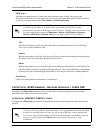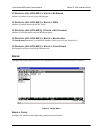
Total Access 600 Series System Manual Section 4 User Interface Guide
61200624L1-1B © 2004 ADTRAN, Inc. 111
L2 P
ROTOCOL
(ATM F
IRMWARE
) – N
ETWORK
I
NTERFACE
> C
U
M
TN
FRE
Configure the L2 P
ROTOCOL
parameters and view the status of the network interface using Copper
Mountain Frame Relay protocol from this menu.
L2 PROTOCOL (ATM–NET–CUMTN) > CONFIG
Configure the L2 P
ROTOCOL
parameters for the network interface using Copper Mountain Frame Relay
protocol.
POTS S
TATS
Selecting this menu options will show real-time indication status of each voice port on the
Total Access 600 Series. On a per port basis, the user can determine which ports are active/inactive
as well as view other statistics like
T
X
Q, I
NSERTS
and D
ROPS
INDICATORS
.
The Echo Canceller module ADPCM functionality automatically shifts ON/OFF when fax
or modem calls are placed. To find out the current status of the Echo Canceller
functionality, check the current status of each FXS port. The path of the current status can
be found at the following path:
L2 P
ROTOCOL
> S
TATUS
> PVC S
TATUS
> P
ROTOCOL
S
TATUS
> POTS S
TATS
> C
ODING
T
YPE
(this will display either PCM of ADPCM).
T
X
Q
Displays the numbers of cells waiting in the buffer to transmit out the POTS port. Buffering
voice cells is used to minimize jitter.
I
NSERTS
Displays the number of cells the Total Access 600 Series inserted on the analog interface to keep
the current voice call connected when the network is idle.
D
ROPS
Displays the number of voice cells the Total Access 600 Series dropped due to a full buffer. This
indicates that the network is sending traffic faster than the Total Access 600 Series is anticipating
receiving cells; thus overrunning the jitter buffer. Excess drops could cause a timing mismatch.
C
LEAR
S
TATS
Clears all recorded statistics and returns all counters to 0.
To insert a new profile, press the
I
key when over the
N
UM
column. A new inserted profile
will always be set up with the default parameters. To copy parameters from an old profile
to this newly inserted profile, use the copy (
C
) and paste (
P
) keys. Entire configuration
trees can be copied with this method.To delete an unused profile, use the
D
key when the
cursor is over the number in the
NUM
column. Once deleted, the profile is gone
permanently.


















